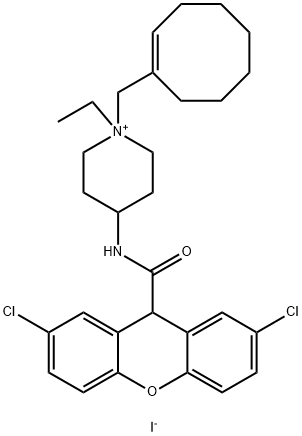353791-85-2
 353791-85-2 結構式
353791-85-2 結構式
基本信息
1,4-CIS-1-(1-CYCLOOCTEN-1-YLMETHYL)-4-[[(2,7-DICHLORO-9H-XANTHEN-9-YL)CARBONYL]AMINO]-1-ETHYLPIPERIDINIUM IODIDE
物理化學性質(zhì)
常見問題列表
|
CCR1 0.9 nM (IC 50 , Human CCR1) |
CCR1 5.8 nM (IC 50 , Mouse CCR1) |
CCR3 0.58 nM (IC 50 , Human CCR3) |
CCR3 460 nM (IC 50 , Mouse CCR3) |
Modified Vaccinia virus Ankara (MVA) but not MVA and vaccinia virus (VACV) infected MH-S cells increase the expression of the CXCR2 acting chemokine CXCL2. MH-S cells constitutively produce CCL2 and CCR1 acting chemokines CCL3, CCL5 and CCL9. Consequently, supernatants of mock treated and virus infected MH-S cells induce chemotaxis of murine promyelocyte MPRO cells and human monocytic THP-1 cells at the same level. However, supernatants of MVA infected MH-S cells significantly increase chemotaxis of the CCR2 deficient human monocytic cell line U-937. Chemotaxis of all above cell types is inhibited by J-113863.
J-113863 (3-10 mg/kg; intraperitoneal injection; once daily; for 11 days; DBA-1 male mice) treatment improves paw inflammation and joint damage, and dramatically decreases cell infiltration into joints in arthritic mice.
| Animal Model: | DBA-1 male mice (10-12 weeks) induced with Collagen |
| Dosage: | 3 mg/kg, 10 mg/kg |
| Administration: | Intraperitoneal injection; once daily; for 11 days |
| Result: | Improved paw inflammation and joint damage, and dramatically decreased cell infiltration into joints. |